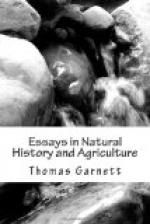Here in the Ribble the Salmon fisheries are not quite so near extinction (though they are rapidly progressing in that direction), for although we are very seldom allowed to see or catch fish in seasonable condition, a good many come up the river to spawn, though very few of them ever do so, and very few of those that do ever reach the sea again. The reason is obvious, no one here has any interest in preserving the spawning fish, and they are openly killed by the poachers, who never dream of being prosecuted for it. I am credibly informed that in a stream not five hundred yards from where I write, sixty spawning fish were killed last winter. Some years ago one gang of poachers killed three hundred Salmon on the spawning beds in one season, and sold potted Salmon roe (which is a most destructive bait for Trout) to the value of L20.
In the Lune the proprietors of the fisheries near Lancaster sent men to protect the spawning fish in the streams above; but these men were warned off by the landed proprietors, who said, If you catch all the good fish you must at least allow us to catch the bad ones. In the Tweed and its tributaries it used to be quite as bad (what the new Scotch law has done I do not know), but a poacher who gave evidence before the Committee of the House of Commons in 1825 said that he had assisted to take four hundred Salmon at one haul in close time in the Tweed.
Sir Walter Scott’s vivid description of burning the water, which occurs in “Guy Mannering,” shows that he knew how to kill Salmon in close time. In fact, his account, and that of Hogg (the Ettrick Shepherd), show that both were regular black fishers.
There are various devices for killing the fish in close time: they are speared, netted, and hooked on the spawning beds, and when the rivers get low, gangs of idle fellows range up and down on the banks, stoning and beating the water by poles, or, what is more effective still, a large bone, or horse’s skull, and by fastening a cord to it, one end of which is passed to each side of the river, they draw this skull up and down in the pools where they know there are Salmon, and the fish are so foolish and timid, that they thrust their heads under any stone or cover they can find, and are taken without trouble; it being common enough in such cases to slip a noose over the tail, then tightening it, and the fish is hauled out immediately.




